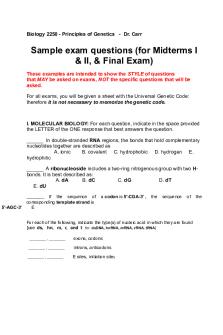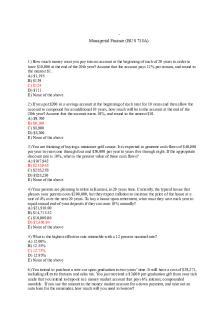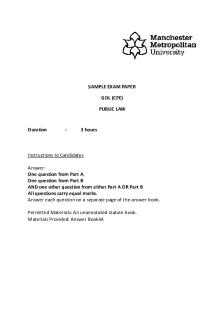Sample/practice exam, questions PDF

| Title | Sample/practice exam, questions |
|---|---|
| Course | Media |
| Institution | Victorian Certificate of Education |
| Pages | 6 |
| File Size | 131.3 KB |
| File Type | |
| Total Downloads | 45 |
| Total Views | 175 |
Summary
Topic - History of Video Tape and TV Recording...
Description
The History of Video Tape and Television Recording year 11 media 1. Oberlin Smith published an original drawing of how magnetic recording could work. In what year was that? The year was 1888 2. How did his device work? The spoken words were transformed by the telephone into an electrical sound carrier, passing through the recording head and into the battery then taken up the reel, to the supply reel and then to the reel brake. 3. Who invented the Telegraphone and when? Vlademar Poulsen in 1898 4. Whose voice was on the oldest magnetic sound recording? Emperor Franz Joseph 5. When was wire and steel tape replaces and with what? It was replaced in 1918 and it was replaced with wax cylinder phonographs. The Magnetophone 6. When did the development on the magnetophone start and in which city and Country? In 1930 the AEG in Berlin Germany started the development of a Magnetophone machine 7. How many meters of magnetic tape did BASF ship in 1934? 50,000 8. What did the tape consist of? The tape consisted of a foil of cellulose acetate as carrier material, coated with a lacquer of iron oxide as magnetic pigment and cellulose acetate as a binder. 9. When and where was the first public recording using the Magnetophone? It was during the 1935 Radio Fair in Berline 10. What was special about the tape? What was it made out of? It was an improved formulation based on Fe304 Ferric Oxide rather than the original Carbonal Iron which was chemically less stable and had a poor dynamic range of under 30db. 11. The magnetophone had a number of advantages-what were they? It was portable Self contained Had its own amplifier and speaker It was cheaper and more reliable than the steel wire and tape machines It was financed It was manufactured by large and powerful corporations in Germany 12. What was its dynamic range and frequency response in 1941? It produced a 60db dynamic range and the 50-10,000 kHz frequency response 13. What did major John T Mullin do? He brought the Magnetophone to America at the end of the war 14. Fritz Pfleumer invented sounding paper in 1928. What gave him the idea for that and what was it? When he was on holiday in Paris on a business trip in 1927 for the Universelle Company the made cigarette machines, he thought of coating paper tape with Iron oxide in the same way that he had been coating cigarette paper with
bronze powder lacquer. 15. What company invented compact cassette tape and when? In 1965, the Phillip company introduced the compact cassette for consumer audio recording and playback on small portable machines such as the Norelco Carry-Corder 150.
The VTR 16. What did Toshiba demonstrate in 1959? Toshiba demonstrated prototype helical scan model VTR-1, with 2-inch tape running at 15 ips over just one head. 17. When was the first instant reply on commercial television? It was in march 1967 at the ABC World series of Skiing in Vail Colorado 18. What equipment was used? It was not a videotape but it was the Ampex HS-100 colour video magnetic disk recorder The Tape 19. What does magnetic tape consist of? It consists of a thin plastic base material, and bonded to this base is a coating of ferric oxide powder 20. What are twp of magnetic tapes most appealing features You can record anything you want instantily and the tape will remember what you recorded for playback at any time and you can also erase the tape and record something else on it any time you like. 21. Tapes have gone through several format changed over the years. What were these? Thin steel wire then the first tape recorders using pxide tapes in the 1930’s on a reel to reel formate, then into the compact cassette tape. 22. How long is a 90 minute cassette? 443 feet (135 meters) long
The Tape Recorder 23. What is the basic idea behind the tape recorder? It involves an electromagnet that applies a magnetic flux to the oxide on the tape. The oxide permanently “remembers” the flux it sees. 24. What is the electromagnet made of? It consists of an iron core wrapped with wire 25. Draw the Simple diagram of the electromagnetic head on page 15
26. What is the job of the capstan roller inside a cassette player? The roller applies pressure so that the tape is tight against the capstan 27. Tape travels at what standard speed? 4.76 cm per second 28. There are four different types of tape today-what are they? Type 0- this is the original ferric-oxide tape. It isn’t really seen these days so it’s not one of the ‘4’. Type 1- This is the standard ferric-oxide tape, also referred to as “normal bias” Type 2- This is “chrome” or CrO2 tape. The ferric-Oxide particles are mixed with chromium dioxide. Type 4- This is metal tape. Metallic particles rather than metal oxide particles are used in the tape. 29. What is a VTR It is a Video Tape Recorder. It can record audio and video material on reels of magnetic videotape from a television broadcast so it can be played back later 30. What is a VCR? A VCR is a video cassette recorder. It is a type of video tape recorder that uses Cassettes 31. When and who introduced the first commercially successful video recorder? Ampex in 1956. 32. What was it referred to as? 2” Quadruplex format 33. Who made the first reel to reel VTR and when? Sony in 1964 34. What was Sony’s U-matic system? What was the maximum playing time for cartridges and how wide was the tape? It was the compact audio cassette and Instamatic film cartridge in 1963 and the super 8 home movie cartridge in 1966. It used ¾ inch (1.9 cm) tape and had a maximum playing time of 90 minutes. 35. Why was it called U-matic? It was named after the shape of th tape path when it was threaded around the helical video head drum, which resembled the letter U. 36. In the early 1980’s Sony introduced High Band or BVU- what were its Advantages? It had an improved colour recording system and lower noise level. It gained heaps of popularity in ENG and location programme making, putting an end to the 16mm film in everyday production. 37. What was the Avco Cartrivision system? It was a combination of a television set and a VCR from cartridge television INC. It sold for US $1,600 and was the first videocassette recorder to have pre-recorded tapes of popular movies available for rent. VHS Versus Betamax 38. When did Betamax first arrive? It was first to the market in November 1975 39. What were the advantaged of VHS over Betamax? VHS had twice the recording time than Betamax did, VHS had a greater availability to pornography, JVC and Sony used different marketing models
for their technology and fewr companies were licensed to produce Beta machines, The VHS camp had access to high street TV rental chains. 40. Various reasons are given for the failure of the Beta Format. What were these? The same reasons stated in question 39 except they are the disadvantages to the Beta Format rather than the advantages to the VHS. Consumer Format 41. List down all the consumer video formats MiniDV Digital 8 (Sony) Video 2000 (Philips) Betamax VHS S-VHS (JVC) VHS-C (JVC) Video8 Hi8™ MICROMV™ Cartrivision 42. Explain Paul Nipkow’s electromagnetic television system of 1884 Paul Nipkow devised the notion of dissecting the image and transmitting it sequentially. To do this he designed the first television scanning device. 43. What was the Radiovisor? Radiovisors were mechanical scanning-drum radiovision devices manufactured by the Jenkins Television Corporation, Founded in 1928 the company sold several thousand sets to the public that cost between $85 and $135. 44. Which two men should get the credit for the first practical TV signal generator? It should be shared by Vladimir K. Zworykin and Philo T.Farnsworth 45. What is CRT? CRT is a specialized Vacuum tube in which images are produced when an electron beam strikes a phosphorescent surface. 46. When was the first CRT invented and by whom? It was first invented by the German scientist Karl Ferdinand Braun in 1897. 47. Draw the diagram of the Cathode ray tube on page 35
48. When did the first successful colour television system begin broadcasting? A German patent in 1904 contained the earliest recorded proposal for a colour television system. The first successful colour television system began commercial broadcasting, first authorized by the FCC on December 17, 1953 based on a system designed by RCA. Read page 45 49. When was the first reel-to-reel videotape recorder created and by whom? It was created in 1956 by Charles Ginsburg and Ray Dolby while working for the Ampex Corporation 50. When and who created the first inexpensive VCR? Sony in 1969 Read pages 46 and 47 51. Explain what is meant by the term Helical scanning. Draw the diagram to help explain it. Helical scanning is the rotating head approach and this is a diagram to help Explain it.
52. Draw the tape path diagram on page 48
It emits the visible light and brings out the colour. 54. What is high definition Television? How is HDTV different? HDTV is the highest DTV resolution around these days. It creates a stunning image with and stunning sound when combined with Dolby Digital surround sound. The higher resolution picture is the main selling point for the HDTV. It has 720 or 1080 lines of resolution where’s as people in the united states have 525 so our quality of image is much better....
Similar Free PDFs

Exam, questions
- 1 Pages

Exam Questions
- 9 Pages

Exam, questions
- 7 Pages

Exam, questions
- 9 Pages

Exam, questions
- 62 Pages

Exam, questions
- 8 Pages

Exam, questions
- 5 Pages

Exam, questions
- 5 Pages

Exam, questions
- 2 Pages

Exam, questions
- 10 Pages

Exam, questions
- 2 Pages

Exam, questions
- 24 Pages

EXAM, questions
- 6 Pages

Exam, questions
- 8 Pages

Exam, questions
- 21 Pages

Neuro Exam questions - Past exam
- 12 Pages
Popular Institutions
- Tinajero National High School - Annex
- Politeknik Caltex Riau
- Yokohama City University
- SGT University
- University of Al-Qadisiyah
- Divine Word College of Vigan
- Techniek College Rotterdam
- Universidade de Santiago
- Universiti Teknologi MARA Cawangan Johor Kampus Pasir Gudang
- Poltekkes Kemenkes Yogyakarta
- Baguio City National High School
- Colegio san marcos
- preparatoria uno
- Centro de Bachillerato Tecnológico Industrial y de Servicios No. 107
- Dalian Maritime University
- Quang Trung Secondary School
- Colegio Tecnológico en Informática
- Corporación Regional de Educación Superior
- Grupo CEDVA
- Dar Al Uloom University
- Centro de Estudios Preuniversitarios de la Universidad Nacional de Ingeniería
- 上智大学
- Aakash International School, Nuna Majara
- San Felipe Neri Catholic School
- Kang Chiao International School - New Taipei City
- Misamis Occidental National High School
- Institución Educativa Escuela Normal Juan Ladrilleros
- Kolehiyo ng Pantukan
- Batanes State College
- Instituto Continental
- Sekolah Menengah Kejuruan Kesehatan Kaltara (Tarakan)
- Colegio de La Inmaculada Concepcion - Cebu